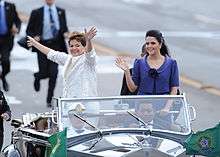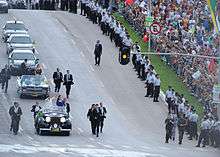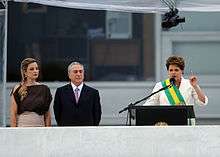First inauguration of Dilma Rousseff
The inauguration of Dilma Rousseff as the 36th President of Brazil took place on Saturday, January 1, 2011. This inauguration marked the beginning of the four-year term of Dilma Rousseff as President and Michel Temer as Vice President. The event had been awaited with some expectation, since Rousseff became the first woman in the history of Brazil to take office as President. It was also the first inaugural ceremony of the New Republic and of the democratic rule in which an outgoing President passed his office to a successor belonging to the same political party as him – the Workers' Party.[1]
 Dilma Rousseff takes the oath of office of the President of Brazil. | |
| Date | 1 January 2011 |
|---|---|
| Time | 3:00 pm (BRST) |
| Location | National Congress of Brazil Brasília, DF |
| Participants | Dilma Vana Rousseff 36th President of Brazil — Assuming office Michel Miguel Elias Temer Lulia 25th Vice President of Brazil — Assuming office José Sarney de Araújo Costa President of the Federal Senate — Administering oath Luiz Inácio Lula da Silva 35th President of Brazil — Leaving office |
Context

The inauguration marked the formal culmination of the Presidential transition of Dilma Rousseff that began when she won the Brazilian presidential election on October 31, 2010, and became the President-elect.[2] The results were certified by the Superior Electoral Court on December 17, 2010.[3]
Rousseff, who campaigned using the slogan "For Brazil to keep on changing", was widely celebrated as the first female president of Brazil and a symbol of continuity from her highly popular predecessor, Luiz Inácio Lula da Silva. According to the Sensus polling institute, Lula might have been the most popular head of state in the world.[4] Approved by 87% of Brazilians at the end of his term, his popularity level beat those of Michelle Bachelet (84%), Nelson Mandela (82%), and Tabaré Vázquez (80%) in their respective home countries.[4] According to David Rothkopf, she inherited "a country with very high expectations", since Lula had "overseen an economic boom, major social reforms and the elevation of Brazil's standing to the top ranks of nations in the world".[5]
Planning
The inauguration was planned primarily by a group composed by members of the Presidential transition, the Ministries of External Relations and Defence, in addition to the Presidency of the Republic.[6] Although the election was scheduled for October 3 (first round) and October 31, 2010 (second round), the group began planning the inaugural ceremony even prior to that.[7]
Invitations

The group organizing the inauguration distributed invitations for the swearing in ceremony to foreign and national authorities, in addition to Rousseff's and Temer's relatives.[8] The ceremonial body of the Senate had sent invitations to all Federal Deputies and Senators of the current legislature, and also to those who will be sworn in on February 1.[9] The invitations were not transferable,[7] each one of them having a barcode to identify the guests by name and photo.[7]
Until December 30, 2010, the publishing house of the Senate had printed 1,500 invitations for Rousseff's swearing in.[10] The National Congress had been expected a total of 2,000 guests for the ceremony,[9] but ultimately a thousand guests witnessed Rousseff's and Temer's swearing in on the floor of the Chamber of Deputies, where a solemn session of the Congress was held.[11] Last minute invitations could have been printed at the request of the Ministry of External Relations and the federal government.[8]
The swearing in was accompanied by representatives of 132 countries.[12] According to the Presidency of the Republic, ten Presidents, nine Prime-Ministers and one Vice-President attended the ceremony, in addition to 132 ambassadors and United Nations representatives.[12] The vast majority of leaders which attended were from Latin America.[12] Representatives of major trade partners of Brazil, such as France, India, and China, were absent.[12] According to Celso Amorim, the non-attendance was due to the fact that the Brazilian inauguration is held on January 1.[12] "We always wish that more people attend, but the date is really unfortunate", he said.[12]
For the reception held at the Itamaraty Palace, the Ministry of External Relations issued 2,500 invitations at the request of the Presidential transition and the Presidency of the Republic.[13] Over 300 foreign authorities attended, in addition to Governor of São Paulo Geraldo Alckmin, which had been absent from the inaugural ceremony.[14]
Rehearsals

On December 19, 2010, the first rehearsal for the inaugural ceremony of Rousseff was held.[15] Juliana Rebelo, a civil servant of the Senate, acted as her during the rehearsal, which was closely watched by journalists and curious passers-by.[15] The second and final rehearsal was held on December 26, this time featuring the 1952 Rolls-Royce Silver Wraith which serves as the President's celebratory car.[15] That same day, Rousseff told the group responsible for organizing her inauguration that she will not be taking her mother nor her daughter with her at the Silver Wraith.[16] Traditionally, the President-elect parades alongside his spouse, but Rousseff is divorced.[16] Nevertheless, at the inauguration, Rousseff changed her mind and took daughter Paula to parade with her.[17]
The news portal G1, which accompanied the rehearsal, anticipated that the inauguration would be "quite a feminine party".[18] Important female figures in Brazil's history were honored with panels spread across the Monumental Axis.[18]
Inaugural events
Arena Brasil
The Ministry of Culture organized the cultural part of the inauguration, having provided a budget of 1.5 million reais (around 0.9 million U.S. dollars) for the event.[19] The first part of cultural presentations, named Arena Brasil,[20] began at 10:00 am (08:00 UTC) and ended at 2:00 pm (12:00 UTC), with the start of the official inauguration ceremony.[21]
Arena Brasil honored the regions of Brazil.[20] From 10:00 am (08:00 UTC) until 12:00 am (10:00 UTC) there were presentations of children's groups.[20] There were also musical presentations from 10:00 am (08:00 UTC) until 2:00 pm (12:00 UTC) in each of the four tents spread along the Monumental Axis, honoring the North, Northeast Region, Brazil, Southeast and South regions of Brazil.[20]
The Arena Brasil project, which began at Rousseff's inauguration, is expected to continue in civic dates throughout Brazil.[20] Five major events are planned for 2011.[20] The next Arena Brasil event will be held in the Northeast on April 22 to commemorate the date which marks the arrival of Pedro Álvares Cabral in Brazil.[20] On August 11, the Black Consciousness Day will feature an Arena Brasil event in the Southeast.[20] The Independence Day will feature an Arena Brasil event in the South, while the Proclamation of the Republic Day will feature the project in the North.[20]
Parade
Rousseff left the Granja do Torto residence at 2:00 pm (12:00 UTC) and arrived at the Cathedral of Brasilia at 2:15 pm (12:15 UTC).[22] It began to rain right after she left the residence, and she could not parade to the Congress with the hood open, frustrating the public.[22][23] Nevertheless, Rousseff opened the car window to wave her hand at the public.[24] The car wandered through the Monumental Axis, stopping at the National Congress, where, around 14:30 hours UTC−2 (2:30 pm), Rousseff and Temer were received by the President of that body, José Sarney.[21]

On the floor of the Chamber, both of them will sign a term agreeing with the demands of the office, and Rousseff will make her first speech as President.[21] Prior to that, they will be sworn in, taking the oath of "maintaining, protecting and fulfilling the Federal Constitution, comply with the laws, promote the general welfare of the Brazilian people, sustain the unity, integrity and independence of Brazil".[6] Around 16:00 hours UTC−2 (4 p.m.), Rousseff and Temer will leave the Congress building towards the Palácio do Planalto.[21] At 16:30 hours UTC−2 (4:30 pm), they will be welcomed at the presidential palace's ramp by the outgoing President Luiz Inacio Lula da Silva and his wife.[6] Traditionally, the outgoing vice President and his wife also greet the new President, but José Alencar is undergoing colorectal cancer treatment in São Paulo's Hospital Sírio-Libanês and shall not attend the inauguration.[25]
In the parlor (speaker's platform), located in the outer area of the palace, overlooking the Three Powers Plaza, Lula will pass the presidential sash to Rousseff.[6] Wearing the sash, Rousseff will be greeted by heads of state and other authorities in the palace's east wing.[6] Around 17:00 hours UTC−2 (5 p.m.), Rousseff will head to the parlor and make her first speech to the people as President.[21] Then, Rousseff will induct her 37 ministers inside the palace.[6] Once this stage of the ceremony has passed, Rousseff will offer a reception to foreign authorities that were sent to Brazil to witness her inauguration at about 18:30 hours UTC−2 (6:30 pm).[21] Each foreign authority will have the opportunity to speak with Rousseff for 30 seconds.[21]
Concerts
The inaugural day featured concerts by five Brazilian female singers: Elba Ramalho, Fernanda Takai, Mart'nália, Zélia Duncan, and Gaby Amarantos.[19]
According to the newspaper Diário do Pará, the Ministry of Culture chose these singers to represent all five regions of Brazil.[26] However, both Fernanda Takai and Mart'nalia come from the Southeast Region. Rio de Janeiro-born Zélia Duncan began her career in Brasília, while Elba Ramalho hails from Paraíba and Gaby Amarantos was born and raised in Pará.[26] Therefore, none of the singers hails from the Southern Region.
Attendance
Organisers expected over 70,000 people to attend the inaugural ceremony at the Monumental Axis.[18] The attendance was expected to match that for Lula's first inauguration in 2003, which was attended by an estimated 70,000–120,000 people.[27][28]
Security

At the first event of the inauguration, an open car parade from the Cathedral of Brasília to the National Congress, 2,650 agents of the Military Police, Civil Police, Federal Police and Federal Highway Police were present. In Congress, where the handover took place, another thousand police and military officers guarded president-elect and guests. Of this total, about 400 were soldiers from the Army, Navy and Air Force.[29]
Throughout the parade, snipers were in strategic locations, including the roofs of public buildings, while highly trained dogs enhanced security on the sidewalks. To protect foreign representatives, including 25 heads of state or government, 650 men were deployed by the Federal Police. Rousseff's personal safety was ensured by 65 federal agents. At her request, the inner circle was formed by trained female agents, who formed a shield around her.[29]
None of the parliamentarians were allowed to bring guests of their own to the ceremony.[9] The invitations are individual, and a map indicating the entrance which guests had to use to get into the plenary of the Chamber were attached to them.[9] Unlike previous inaugural ceremonies, the guests had to go through metal detectors in order to gain access to the Congress, with the exception of Deputies, Senators and heads of state.[9] Also as a security measure, the ceremonial body of the Senate called for the cancellation of guided tours around the premises of the building starting on December 29.[9]
Broadcast
Rousseff's inauguration was broadcast nationally by all major television networks. In order to ensure that there would be no "blind spots" during the broadcast, organisers allowed helicopters from private TV networks to fly over the Monumental Axis, in addition to installing a TV Senado camera, equipped to capture images at long ranges, atop the 28th floor of the Senate Annex I building.[30]
Gallery
- Rousseff's Inaugural Parade at the Ministries Esplanade. Police motorcycles and bodyguards surround the Presidential Rolls-Royce, followed by a 1968 Cadillac De Ville convertible used by Vice President Michel Temer.
- Dilma Rousseff inspecting the Presidential Guard
- Rousseff reviews troops of the Armed Forces.
 Dilma Rousseff beside her daughter Paula, en route to the Planalto Palace.
Dilma Rousseff beside her daughter Paula, en route to the Planalto Palace.- Dilma Rousseff climbs the Planalto Palace's ramp with Michel Temer.
- Outgoing President Luiz Inácio Lula da Silva and First Lady Marisa Letícia receive President Rousseff and Vice President Temer in front of the Planalto Palace.
 Michel Temer, Dilma Rousseff, Lula da Silva and Marisa Letícia at Rousseff's inaugural ceremony.
Michel Temer, Dilma Rousseff, Lula da Silva and Marisa Letícia at Rousseff's inaugural ceremony.- Rousseff, next to Vice President Temer, bids farewell to former President Lula and wife Marisa Letícia.
 President Rousseff delivers a speech to the people on the parlatorium (speaker's platform) of the Planalto Palace. Beside her are Vice President Temer and his wife Marcela.
President Rousseff delivers a speech to the people on the parlatorium (speaker's platform) of the Planalto Palace. Beside her are Vice President Temer and his wife Marcela. Felipe of Spain, then Prince of Asturias, kisses the hand of President Rousseff.
Felipe of Spain, then Prince of Asturias, kisses the hand of President Rousseff. President Rousseff with President Hugo Chávez of Venezuela.
President Rousseff with President Hugo Chávez of Venezuela.
References
- "A eleição de Dilma Rousseff". O Estado de S. Paulo. November 2, 2010. Retrieved December 26, 2010.
- Yapp, Robin. "Dilma Rousseff elected Brazil's first female president". The Telegraph. October 31, 2010. Retrieved January 1, 2011.
- (in Portuguese) "Diplomada presidenta, Dilma exalta Lula e condição de mulher". Último Segundo. Retrieved December 22, 2010.
- (in Portuguese) Jubé, Andrea and Pires, Carol. "CNT/Sensus: aprovação de Lula é recorde mundial". O Estado de S. Paulo. December 29, 2010. Retrieved January 1, 2011.
- Rothkopf, David. "The challenges of picking the right predecessor, Brazil style". Foreign Policy. September 29, 2010. Retrieved January 2, 2011.
- (in Portuguese) Londres, Mariana. "Equipe de Dilma marca dois ensaios para garantir “perfeição” na posse". R7. December 19, 2010. Retrieved December 22, 2010.
- (in Portuguese) "Ritos da Posse". Portal Brasil. Retrieved January 2, 2011.
- (in Portuguese) Costa, Rosa. "Posse de Dilma já tem 1.229 convites impressos". O Estado de S. Paulo. December 20, 2010. Retrieved December 22, 2010.
- (in Portuguese) Folha Online. "Congresso espera 2.000 convidados para cerimônia de posse de Dilma". Agora MS. December 21, 2010. Retrieved December 22, 2010.
- (in Portuguese) Chalub, Ana. "Gráfica do Senado preparou 1.500 convites para a posse de Dilma Rousseff". TV Câmara. December 30, 2010. Retrieved January 3, 2011.
- (in Portuguese) Vidigal, Fernanda. "Mil convidados prestigiam a posse de Dilma no Congresso". Jornal do Senado. January 1, 2011. Retrieved January 3, 2011.
- (in Portuguese) Caprioli, Gabriel; Fleck, Isabel; Sabadini, Tatiana and Khodr, Carolina. "Dilma começa governo de olho no plano externo". Estado de Minas. January 2, 2011. Retrieved January 3, 2011.
- (in Portuguese) Agência Brasil. "A cerca de 48 horas da posse de Dilma, convites e últimos detalhes são acertados". R7. December 30, 2010. Retrieved January 3, 2011.
- (in Portuguese) iG Brasília. "Com dublê de Dilma, Itamaraty realiza 1º ensaio da posse". Último Segundo. December 19, 2010. Retrieved December 22, 2010.
- (in Portuguese) Guerreiro, Gabriela. "Dilma desfilará sozinha em carro aberto no dia da posse". Folha de S. Paulo. December 26, 2010.
- (in Portuguese) Cobucci, Luciana. "Dilma muda de ideia e desfilará acompanhada da filha". Terra. December 31, 2010.
- (in Portuguese) Redação. "Posse de Dilma vai destacar o papel das mulheres na história do Brasil" Archived October 8, 2011, at the Wayback Machine. Correio da Bahia. December 20, 2010. Retrieved December 22, 2010.
- (in Portuguese) Andrade, Claudia (Terra). "Festa da posse custará R$ 1,5 mi". Blog do Noblat. December 20, 2010. Retrieved December 22, 2010.
- (in Portuguese) "Regiões do Brasil serão homenageadas na festa de posse de Dilma". Terra. December 26, 2010.
- (in Portuguese) Londres, Mariana. "Veja como será a cerimônia de posse de Dilma". R7. December 19, 2010.
- (in Portuguese) Araújo, Glauco. "Professora critica cerimonial por iniciar desfile de Dilma sob chuva". G1. January 1, 2011. Retrieved January 4, 2011.
- http://g1.globo.com/politica/noticia/2011/01/para-saudar-dilma-e-se-despedir-de-lula-30-mil-enfrentam-chuva.html
- "Vice deixa a UTI, mas não vai à posse". Diário do Nordeste. December 31, 2010. Retrieved January 1, 2011.
- (in Portuguese) "Gaby Amarantos embala a posse de Dilma". Diário do Pará. December 21, 2010. Retrieved December 24, 2010.
- (in Portuguese) Londres, Mariana. "Dilma fará trajeto alternativo se chover na posse". R7. December 19, 2010. Retrieved December 22, 2010.
- (in Portuguese) "Posse de Dilma Rousseff movimenta Brasília no fim de ano". R7. December 27, 2010. Retrieved December 28, 2010.
- "Brasília blindada na festa de Dilma". Correio da Manhã. Retrieved on 2010-12-31. (in Portuguese).
- (in Portuguese) Agência Senado. "Posse de Dilma será transmitida por emissoras de TV". Jus Brasil. December 6, 2010. Retrieved December 22, 2010.
External links
| Wikimedia Commons has media related to Inauguration of Dilma Rousseff. |